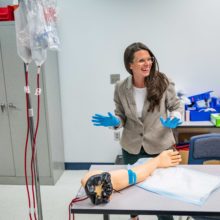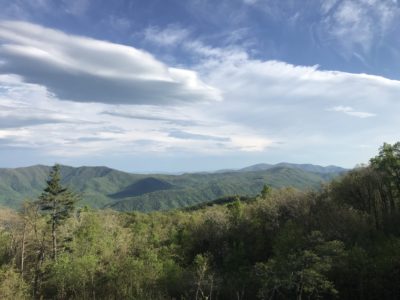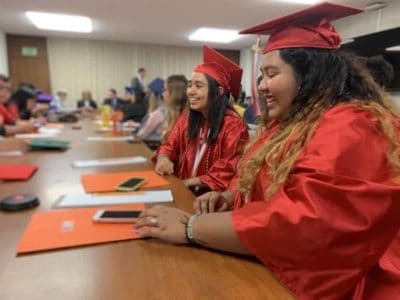

One year ago, myFutureNC Commission announced a shared attainment goal for North Carolina — an aggressive call to action for two million 25-44 year olds to receive a high-quality credential or college degree by 2030. While many regions are working to help the state reach its goal of two million, Land of Sky has been diligently organizing local leaders in an effort to better align educational outcomes with future economic needs.
The Land of Sky Region, located in the mountains of Western North Carolina and including Henderson, Madison, Buncombe, and Transylvania counties, is home to over 430,000 residents. In late 2019, this region had the lowest unemployment rates in North Carolina and nearly all occupational sectors showed positive job growth during the past year. Additionally, educational attainment in the region was slightly higher than the state average. For more data on the four counties, view these county profiles created by Carolina Demography in partnership with myFutureNC.
While positive growth is welcomed, it doesn’t mean there aren’t challenges surrounding the four counties. According to a talent survey by Asheville Chamber, companies in the region are expected to grow over the next three years, adding another 12,700 to 26,700 jobs — with the manufacturing sector expected to experience the greatest growth.
“And that’s the challenge,” said Dr. Michael Dempsey, “supplying the demands of the living-wage workforce.”
Dr. Michael Dempsey, Dean and Director of Lenoir Rhyne University’s Center for Graduate Studies in Asheville, is part of a steering committee that has spearheaded an educational attainment pilot project that is intended to be a model for the state. Joining him on this committee are: Jack Cecil, President and CEO of Biltmore Farms; Dr. Laura Leatherwood, President of Blue Ridge Community College; Nathan Ramsey, Director of the Mountain Area Workforce Development Board with Land of Sky Regional Council; Dr. William Sederburg, former university president and politician; and Dr. Joseph Fox, retired from the NC Community College System and lead coordinator for the pilot project. Over the past seven months, members of this steering committee have worked to garner the support of the area’s K-12 systems, institutions of higher education, and economic developers.
Leaders of the Land of Sky pilot project knew that a bold call to action meant that everyone had to do their part to move the needle towards 2 million by 2030.
“Our leaders were fueled by a desire to see our four-county region be a leader in the myFutureNC initiative,” said Dempsey. “And we were interested in the challenge of boosting educational attainment in specific areas and tying those credentialed employees to sustainable-wage jobs, largely in advanced manufacturing, medical, and professional/business career areas,” he continued.
With Fox coordinating the efforts, the team has made headway collecting data that will aid in the development of an action plan to make meaningful connections between educational attainment and workforce needs.
As I sat down to discuss the pilot project with Dempsey and Fox, their enthusiasm for this project was apparent. They know the work they are doing is meaningful, not just for their region, but for the state. Prior to Fox’s arrival, Dempsey spent months coordinating communications and meetings related to the initiative. Now, Fox meets with local leaders across the four counties, collecting information that will continue the group’s efforts towards implementing an attainment model.
In a perspective piece published in September 2019, Land of Sky leaders discussed myFutureNC’s goal of 2 million by 2030 and how developing an action plan will keep North Carolina competitive and directly impact its residents. As stated in their perspective piece:
“Achieving the two million number would mean bridging an expected 400,000-worker shortfall between our current workforce trajectory and projected workforce needs. If achieved, it would make North Carolina a national leader in postsecondary attainment.”
But developing and implementing an action plan is no small feat. “Some nights I look at the time and realize I’m still responding to emails at 10 pm,” Fox said.
Land of Sky leaders are busy conducting research and meeting with individuals from K-12 systems, higher education institutions, and agencies across the four counties. As they collect information, Fox and others are creating a clearinghouse in hopes that the data can be used to visually connect the dots between educational attainment and workforce needs.
One objective of the project is to collect the best practices used by the educational systems, institutions, and agencies within the region. Over the past few months, Fox has met with local leaders to discuss everything from Pre-K resource bags to collaborative math clubs. These conversations are helping Land of Sky leaders identify programs and initiatives that work well in each of the four counties.
Building an attainment model of this magnitude doesn’t come without challenges. “Communication is particularly difficult, since most agencies, systems, and institutions work in silos,” Fox pointed out. Working independently and often without shared knowledge of what others in the region are doing, opportunities for feedback are limited. “By becoming an information clearinghouse,” Fox said, “we can begin to develop a best practices model.” Land of Sky will rely on the information obtained across the region, the state, and the nation in their endeavor to build this model.
To alleviate siloed communication, Land of Sky leaders are identifying work groups to assess current policy, share expert knowledge, identify available funding, and deliver recommendations. Leaders from Land of Sky hope to create work groups that include individuals from:
- Pre-K.
- K-12 systems.
- Postsecondary institutions.
- Economic development.
- Public and private agencies offering support services.
While Land of Sky leaders continue their research and planning efforts towards an attainment model, one thing is certain — collective impact is key. These leaders understand that ensuring North Carolinians have access to high-quality, relevant educational opportunities requires collaboration across the region and state.
Not only is it a collective effort, but it’s also comprehensive. They believe that a comprehensive approach to building an attainment model looks at educational systems, resources, policy, and economic development to understand the challenges residents of North Carolina encounter when seeking a high-quality credential or college degree.
As Fox said, “Meeting the statewide educational attainment goal doesn’t just start in our high schools. It starts before students enter kindergarten.”
What’s next for the pilot project? Fox and Dempsey hope to have work groups in place within the next three months while they continue assessing information they’ve collected during their research. As they move towards creating a visual resource map, Land of Sky leaders are hopeful that their action plan will serve as a road map for others across the state. With regional collaborations springing up across the state, I’m reminded — the future of North Carolina is bright.



